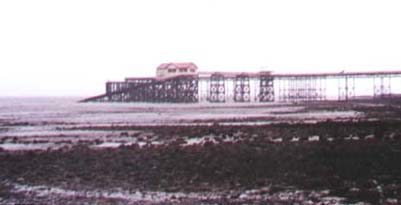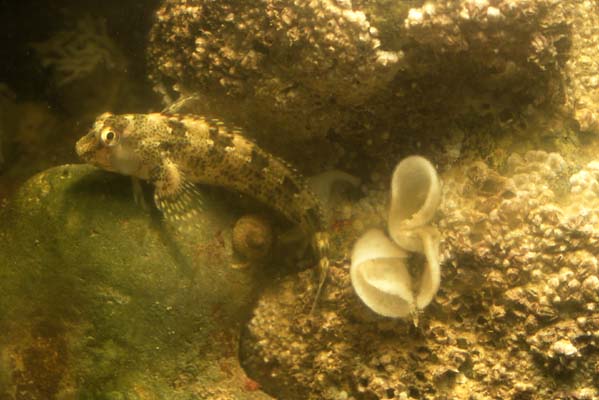On a beautiful sunny and warm August day (a rare event indeed in South
Wales, in 1998), with a gentle breeze blowing from the south-west, I decided
to visit the Mumbles.

Mumbles
Pier in a torrential Welsh downpour
Swansea Bay
This rather picturesque resort is situated at the westerly corner of
Swansea Bay, four miles from the city, but visible from any point of this
magnificently curving bay, that sweeps some seventeen miles of almost continuous
sand, right round to Aberavon, (Port Talbot's beach) at the easterly end
of the curve. This bay has provided a safe haven for many a weary sailor
and was obviously the reason for Swansea becoming a shipping port, in fact,
one of the most important harbours in south Wales throughout the 19th and
early 20th centuries.
Low Tide
I arrived about 90 minutes before the turn of the tide, with the intention
of investigating some, of the many rockpools at The Mumbles and did, in
fact, discover the presence of many tiny fry of 5 mm to 8 mm, too small
to identify. I found some young Sand Smelts, Atherina presbyter,
of 20 mm and captured six of them for my aquarium. I also found, on pieces
of pebble on the bottom of these shallow pools, several small Plumose
Anemones, Metridium senile, and upon lifting one of these, I
spotted a tiny red growth, that on further examination proved to be a very
small Feather Star, Antedon bifida, with
arms of 10 mm.

On the whole I would say that apart from the Sand Smelts, the pools
did not prove very productive, as the usual assortment of Shanny,
Rockling, Sand Eels etc were not in evidence
although a few small Hermit Crabs in their shells,
scuttled about the sandy bottom.
Algae
Scattered all over the exposed rocks at mid to low tide level were the
filamentous strands of the seaweed Purple Laver, Porphyra umbilicalis,
that turn to black when out of the water, but survive to return to the
original brown colour when immersed on the following tide. This weed, when
collected and cooked, becomes the highly popular delicacy in South Wales
known locally as Laver Bread and is normally served with cockles
and bacon!
The seaweed Carragheen, Chondrus
crispus was very evident almost everywhere in the pools, with the iridescence
of the tips, winking at me in the warm sunlight, almost like fairy lights
amongst the red/brown leaves of the parent plant.
Prawns and Rock Pool Fish
I caught quite a number of large Prawns, Palaemon serratus,
of edible size and as the tide was now almost fully out, I made my way
to the Sewer Pipe that runs diagonally under the Mumbles Pier and Lifeboat
Station and is only uncovered on the big tides of the year. Under this
pipe I have found many oddballs over the years and it is also an excellent
area for large prawns.
I did quite well, finding many more prawns, also one large Scorpion
fish (Long-spined Bullhead), Taurulus bubalis,
a small 3-bearded Rockling, several Corkwing
and Ballan Wrasse, (all fish returned to the water),
then I spotted a quite large Long-legged Spider
Crab, Macropodia rostrata, resplendent in seaweeds of many shades,
attached all over it's legs, making it quite difficult to recognise at
first. The legs were 60 mm/ to 70 mm in length and it is now happily perched
on top of a plastic Vallisenaria (seaweed) in my two-metre
long aquarium.
Fouling Organisms
There were ten separate growths of Dead Mens
Fingers, Alcyonium digitatum (all white) at various points
along the pipe and around the pier supports, that are also liberally covered
with Plumose Anemones of white, brown, salmon and a very pretty salmon-white
mixture, amongst many kinds of sponge growth interspersed with Sea Squirts
making this quite a colourful area.
I left the pipe at this point and moved under the pier supports, amongst
this mixture of rusty ironwork and tangled colour, walking on a bed of
mussels that cover the seabed between the supports and range out as far
as I can wade in safety and up the beach to the mid water mark, in an unbroken
mass.
Friendly Visitors
Pushing my net around and under the supports, searching for more Prawns,
I gradually became aware that I was not alone.
The water, was on this day, crystal clear and not three feet from me
was a largish fish that I quickly realised was a Triggerfish
Balistes capriscus (=Balistes carolinensis). It seemed
to show no fear of me at all and it had now been joined by two more Triggerfish
of similar size. They were grey-blue with several slashes of a lighter
colour on the sides and back. Due to refraction and rippling of the surface
water I can only estimate the size at approximately 20 cm belly to back,
and 30 cm nose to tail and weighing about 1.5 kg (3 1b).
I lost all interest in prawning at this point and spent the next fifteen
minutes watching these Triggerfish as they moved around me, sometimes about
40 cm from my legs. I did attempt to net one, just for identification purposes
and to determine size, but it easily evaded my net by turning on it's side
and slipping under a girder, into a space of only 10 cm, only to reappear
moments later circling me again. When I moved, they came with me showing
no fear at all.
 Triggerfish Triggerfish
Knowing the set of teeth that these fish 'possess and as I was bare legged,
perhaps it was I who showed no fear!
Schools of Triggerfish
A large school of these fish have been resident under the Mumbles Pier
for many years now as can be attested by the local anglers who catch them
every summer, with weights of 1 kg to 2 kg being the norm. I have never
seen a young or baby Triggerfish nor heard of one being seen or caught
so we have to assume that they are summer visitors.
Why is it always the Mumbles Pier? Could it be the mussel beds that
attract them or maybe the hundreds of Common Starfish, Asterias rubens,
that regularly feed on the mussels? The Triggerfish has teeth capable of
dealing with either. The area is also alive with young Sand Eels and young
fish of all sorts seem to like the end of the pier for reasons unknown
to me.
 Starfish
feeding on a mussel Starfish
feeding on a mussel
Whatever the reason, it made my day to spend a long fifteen minutes in
such close company with these quite exotic visitors from sub-tropical seas.
Triggerfish off Dorset
(BMLSS Scotland)
Triggerfish
in Rare Fish Records (BMLSS Ireland)
Triggerfish
(UK Aquarium Database)
Triggerfish Database File
Mumbles 2001
Rockpooling Page
Rockpooling at Gelliswick Bay, Milford Haven
Rockpooling Venues
|

